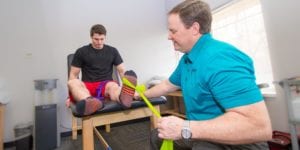What is a Movement Disorder?
The term “movement disorders” refers to a group of neurological conditions that cause abnormal movements, which may be voluntary or involuntary. Movement disorders are conventionally divided into two major categories: Hyperkinetic and Hypokinetic.
Hyperkinetic movement disorders refer to dyskinesia or excessive, often repetitive, involuntary movements that intrude upon the normal flow of motor activity.
Hypokinetic movement disorders refer to akinesia (lack of movement), hypokinesia (reduced amplitude of movements), bradykinesia (slow movement) and rigidity. In primary movement disorders, the abnormal movement is the primary manifestation of the disorder. In secondary movement disorders, the abnormal movement is a manifestation of another systemic or neurological disorder.
What causes a movement disorder?
Causes of movement disorders can include genetics, infections, medicines, damage to the brain, spinal cord, or peripheral nerves, metabolic disorders, stroke, and vascular diseases, or toxins.
What are some common types of movement disorders?
- Ataxia.
- Cervical dystonia.
- Chorea.
- Dystonia.
- Functional movement disorder.
- Huntington’s disease.
- Multiple system atrophy.
- Myoclonus.
- Parkinson’s disease.
- Parkinsonism.
- Progressive supranuclear palsy.
- Restless legs syndrome.
- Tardive dyskinesia.
- Tourette syndrome.
- Tremor.
- Wilson’s disease.
How can physical therapy help with movement disorders?
Physical therapy can help manage symptoms associated with movement disorders. This can include strengthening, balance, and stretching. The physical therapist will develop a comprehensive plan of care in order to help manage symptoms associated with movement disorders. This may include activities to improve balance and proprioception or exercises to strengthen the muscles needed for functional tasks.
Why should I consider physical therapy for my movement disorder?
Adding regular exercise may improve your overall mobility and quality of life. A physical therapist will be able to incorporate specific exercises that may help you reach your goals. This may include walking, jogging, kneeling, and more independence. At Makovicka Physical Therapy we have the expertise to build a truly comprehensive and integrated program to serve patients suffering from movement disorders.
Hannah Wooden, PTA

